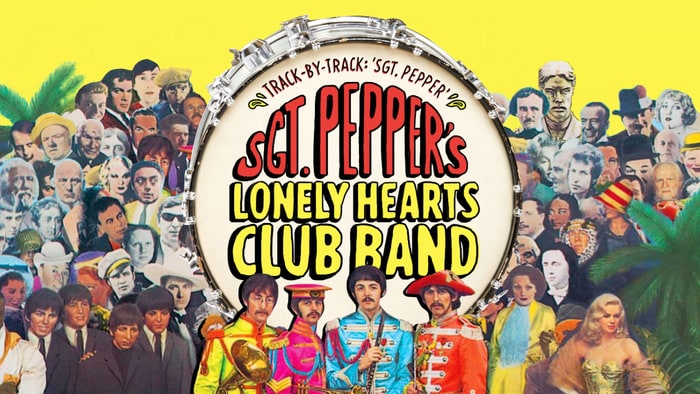Beatles’ ‘Sgt. Pepper’ at 50: What Inspired the Title Track – Rolling Stone

The Beatles’ Sgt. Pepper’s Lonely Hearts Club Band, which Rolling Stone named as the greatest album of all time, turns 50 on June 1st. In honor of the anniversary, and coinciding with a new deluxe reissue of Sgt. Pepper, we present a series of in-depth pieces – one for each of the album’s tracks, excluding the brief “Sgt. Pepper’s Lonely Hearts Club Band” reprise on Side Two – that explore the background of this revolutionary and beloved LP. Today’s installment focuses on how Paul McCartney’s solo travels after the end of the Beatles’ final tour inspired the title track and gave Sgt. Pepper its famous “alter ego” concept.RelatedInside Unheard ‘Sgt. Pepper’ Outtakes: Exclusive First ListenGiles Martin taks us through alternate endings, different instrumentation and studio instructions on massive upcoming set”Right – that’s it, I’m not a Beatle anymore!” George Harrison was heard to exclaim as the band concluded their touring career on August 29th, 1966, with a set at San Francisco’s Candlestick Park. His remark bore a touch of hyperbole, but for the next few months, the Beatles effectively didn’t exist. That fall afforded the foursome the most substantial stretch of personal time they had ever known as adults, allowing each to finally get to know the man he had become after four years as part of a collective identity.John Lennon had been the first to venture out, accepting a part in director Richard Lester’s satire How I Won the War. It was little more than a glorified cameo, but the role required him to be shorn of his famous mop-top – a metaphor if there ever was one – and film on location in West Germany and Spain. Harrison also went abroad several weeks later, pursuing his love of Indian culture by going to the source. Accompanied by his wife Patti, he made a pilgrimage to Mumbai to study sitar under the tutelage of virtuoso Ravi Shankar. Ringo Starr was joyfully playing the family man, spending time with his wife Maureen and baby son Zak in his Surrey estate, Sunny Heights.That left Paul McCartney. “I’m just looking for something I enjoy doing,” he told the Sunday Times that September. “There’s no hurry. I have the time and the money.” For a while he followed his songwriting partner into the cinematic realm by seeking offers to compose a soundtrack. He was ultimately hired to provide music for a dramatic comedy, The Family Way, though the work did little to inspire his creativity. His status as the sole London-based Beatle made him a familiar face at gallery openings, theatrical events, experimental music seminars and avant-garde freak-outs, but the barrage of external stimuli caused him to turn inward. As a youth in Liverpool he relished his solitary moments, sitting on a park bench or the top deck of a bus, playing the detached observer while scribbling in his notebook. He was far too famous to ever indulge in such simple pleasures again, but perhaps a solo road trip – with some extra precautions – would clear his head. On November 6th, McCartney drove his new dark-green Aston Martin DB6 to Lydd Airport in Kent, where it was loaded into the bay of a Silver City Airways superfreighter. McCartney himself relaxed in the 20-seat passenger area for the duration of the plane-ferry’s brief flight to Le Touquet, France. After clearing customs, he disguised his world-famous face with a false mustache specially made by Wig Creations, who had worked with the Beatles on the set of A Hard Day’s Night. “They measure you and match the color of your hair, so it was like a genuine moustache with real glue,” he told biographer Barry Miles in Many Years From Now. “And I had a couple of pairs of glasses made with clear lenses, which just made me look a bit different. I put a long blue overcoat on and slicked my hair back with Vaseline and just wandered around and of course nobody recognized me at all. It was good, it was quite liberating for me.” For the first time in years, McCartney shed the weighty cloak of superstardom and assumed the identity of an anonymous everyman. “I was a lonely little poet on the road with my car,” he later recalled.It’s fitting that the undercover Beatle drove James Bond’s favorite automobile, even though the flashy sports car was hardly inconspicuous in the French countryside. “I was pretty proud of the car. It was a great motor for a young guy to have, pretty impressive,” he recalls. He aimed it towards Paris and the Loire Valley, leisurely pausing to visit chateaus and antique stores along the way. By almost anyone else’s standards, much of his vacation was painfully ordinarily. “I’d cruise, find a hotel and park. … I’d walk around the town and then in the evening go down to dinner, sit on my own at the table, at the height of all this Beatle thing, to balance the high-key pressure. Having a holiday and also not be recognized. And re-taste anonymity.”He kept a journal of the trip, and shot reel after reel of 8 mm film, making short, atmospheric movies partially inspired by his acquainta
Source: Beatles’ ‘Sgt. Pepper’ at 50: What Inspired the Title Track – Rolling Stone




There are no comments at the moment, do you want to add one?
Write a comment